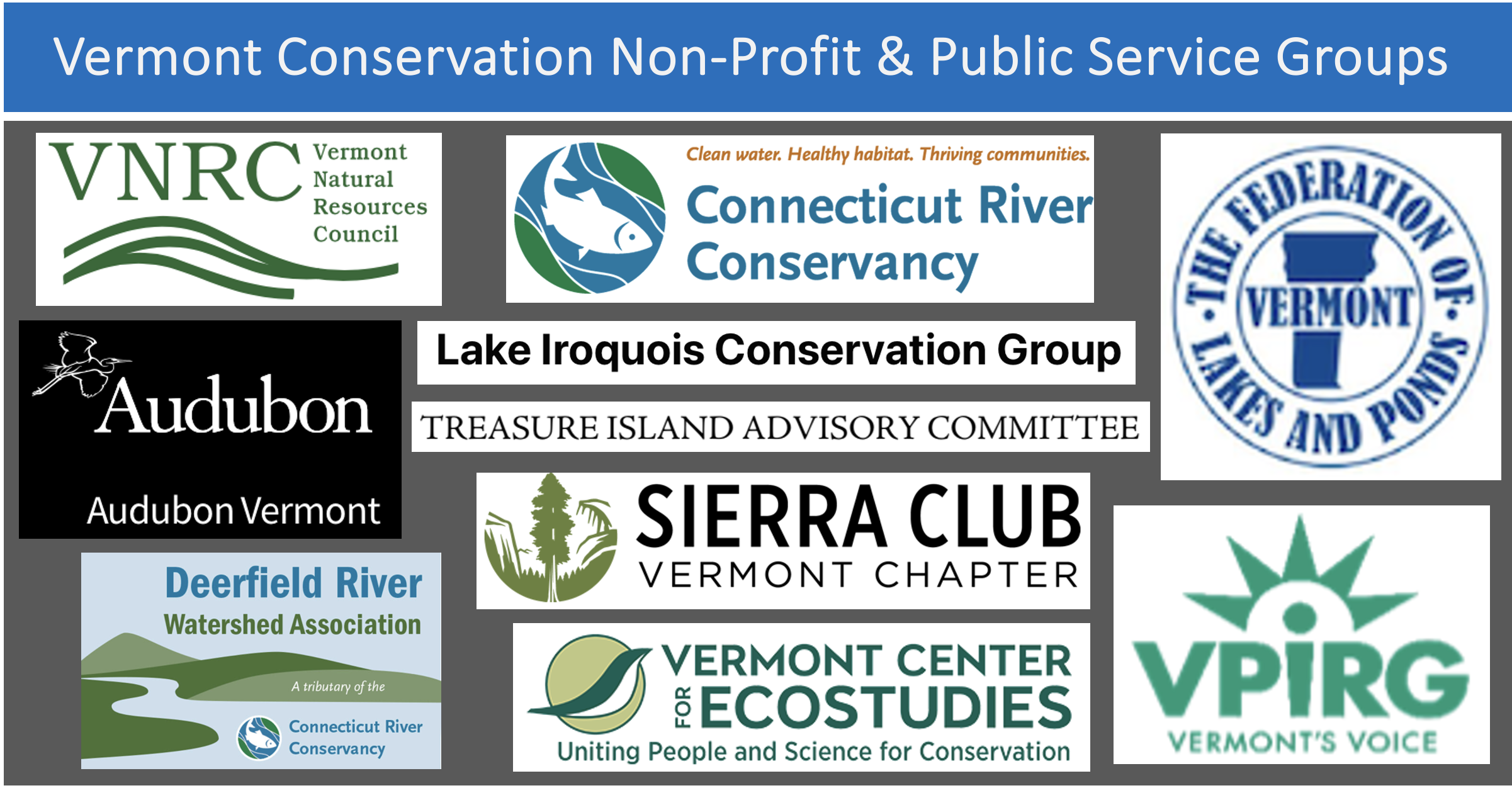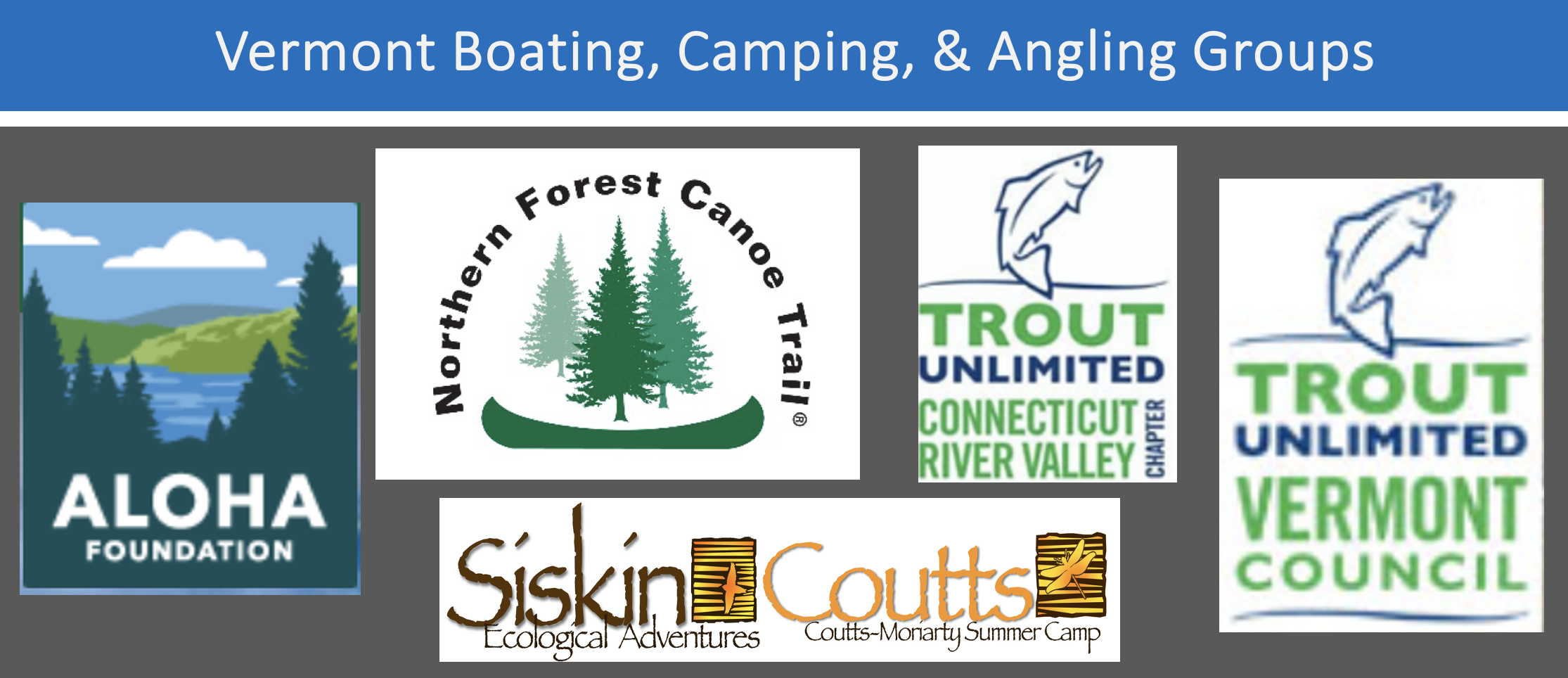Since submission of Responsible Wakes’ Agency of Natural Resources (ANR) petition over 2 years ago, public support for regulation of wake boat activities has burgeoned and continues to grow. In addition to the support from over 1,200 individuals endorsing our March 2021 petition to the ANR, more than 35 state, national, private, and public organizations have endorsed our initiative calling for a “strong rule” for operating wake boats, i.e., a 1,000-foot minimum distance from shore — as opposed to the ANR/DEC’s weak proposal of a 500-foot distance. The strong support of these organizations substantiates the validity of Responsible Wakes’ efforts.

Wake sports conducted too close to shore may result in shoreline/lake bottom damage and personal injury to others enjoying the water nearby.
We provide below a set of graphics displaying the logos of supporting organizations in Vermont grouped by type: 1) conservation, non-profit and public service groups; 2) boating, camping and angling groups; and 3) municipal bodies and commissions.
1. Vermont Conservation Non-Profit and Public Service Groups
The ten Vermont-based conservation and public service groups in the figure below have worked diligently to strengthen Vermont’s national reputation, established half a century ago, of supporting environmental and conservation efforts. Notable among this group are the Vermont Natural Resources Council, Audubon Vermont, the Vermont Center for Ecostudies, the Connecticut River Conservancy, the Vermont Chapter of the Sierra Club, the Federation of Vermont Lakes and Ponds, and Vermont Public Interest Research Group.

Vermont’s well-deserved, non-partisan environmental reputation was earned largely due to the grass roots efforts of concerned, hardworking citizens. Their work contributed to the passage of several major pieces of legislation: the Billboard Ban in 1968 to prevent visual blight on the landscape that continues to impress those visiting Vermont, Act 250 in 1970 to manage environmentally sensitive development, the Bottle Bill in 1972 to address concerns about unsightly roadsides, and the Jet Ski Ban in 1997 to curb gas and noise pollution on lakes and to minimize disruptions to wildlife. We view Responsible Wakes’ petition to manage wake boats in Vermont as representing the next step in Vermont’s legacy as an environmentally friendly state that attracts visitors who share these values.
2. Vermont Boating, Camping and Angling Groups
It comes as no surprise that those who enjoy spending time on the water in traditional recreational activities support a strong rule for wake boats. The individuals who comprise these groups understand what is required to protect water quality, water biodiversity, and ecology, as well as what can and does adversely impact lake environments, such as wake sports. These users are keenly aware of potential conflicts and safety issues when wake boats are added to the traditional mix. Not infrequently, users curtail their activities, suspending their own enjoyment on the water, because of wake boat conflicts. In the case of children and family camps, e.g., Aloha Foundation, Siskin-Coutts, and others, disturbances from wake boats may upset program schedules by preventing campers from participating in programs or events for which they have registered. When campers don’t get what they’ve paid for, they are less likely to return in subsequent years.

3. Vermont Municipal Bodies and Commissions
The dozen municipal bodies and commissions included in the figure below support a strong rule for wake sports. The vigorous efforts of residents living on or near local lakes and ponds played no small part in this development. As local knowledge and understanding of the wake boat issue has spread throughout the state, the number of supporting groups has increased. Of note, during the two-year petition process, we are not aware of any municipal bodies or commissions supporting the ANR/DEC’s weak rule proposing a 500-foot minimum distance from shore.

……………………
In summary, Responsible Wakes’ grass-roots efforts and its success in enlisting the support of the many well-respectedorganizations included above are compelling evidence of the need for a strong rule to appropriately manage wake boat use in Vermont. Vermont’s half-century legacy as an environmentally friendly state. Members of these organizations have first-hand knowledge of the potential adverse effects of wake boats. They understand from the experience of other states that when wake sports are not sufficiently managed, the risk of environmental damage, personal injury, and financial loss is greatly amplified, and the ability to enjoy traditional recreational lake activities is threatened.
ANR received 759 written comments on its draft rule proposing a 500-foot minimum distance from shore. More than 82% of those submissions supported Responsible Wakes’ proposed 1,000-foot minimum distance from shore and half of those (41%) wanted wake boats totally banned from Vermont’s lakes and ponds. If the ANR’s final rule is less than 1,000-foot minimum distance from shore, it will be challenged for evidence to support that decision. Vermont has the opportunity to show real leadership with this decision. Its reputation as a preeminent environmental steward is at stake.
